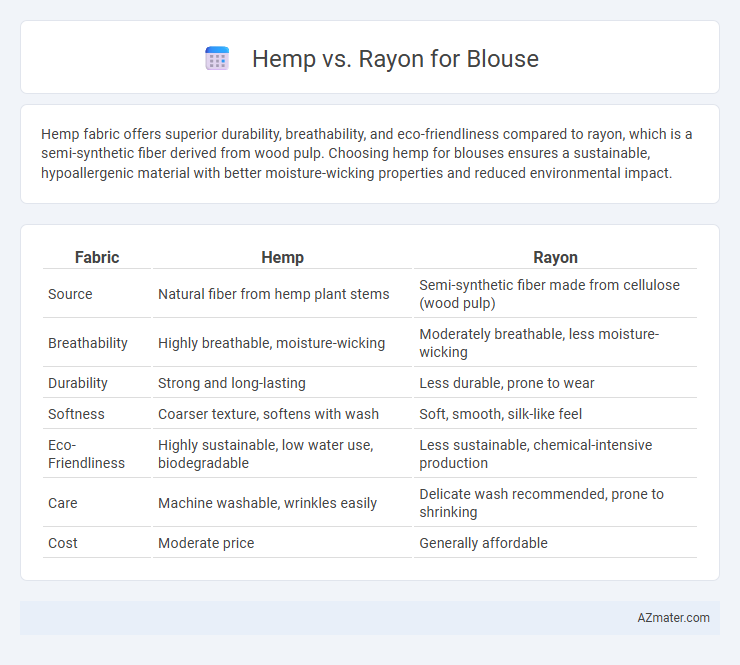Hemp fabric offers superior durability, breathability, and eco-friendliness compared to rayon, which is a semi-synthetic fiber derived from wood pulp. Choosing hemp for blouses ensures a sustainable, hypoallergenic material with better moisture-wicking properties and reduced environmental impact.
Table of Comparison
| Fabric | Hemp | Rayon |
|---|---|---|
| Source | Natural fiber from hemp plant stems | Semi-synthetic fiber made from cellulose (wood pulp) |
| Breathability | Highly breathable, moisture-wicking | Moderately breathable, less moisture-wicking |
| Durability | Strong and long-lasting | Less durable, prone to wear |
| Softness | Coarser texture, softens with wash | Soft, smooth, silk-like feel |
| Eco-Friendliness | Highly sustainable, low water use, biodegradable | Less sustainable, chemical-intensive production |
| Care | Machine washable, wrinkles easily | Delicate wash recommended, prone to shrinking |
| Cost | Moderate price | Generally affordable |
Understanding Hemp and Rayon: An Overview
Hemp is a natural fiber derived from the Cannabis sativa plant known for its durability, breathability, and eco-friendly properties, making it ideal for sustainable blouse fabrics. Rayon, a semi-synthetic fiber made from regenerated cellulose, offers a soft, smooth texture with good draping qualities but involves chemical processing that impacts its environmental footprint. Understanding the differences in fiber origin, production methods, and fabric characteristics helps consumers choose between the natural strength and sustainability of hemp versus the silky feel and affordability of rayon for blouses.
Production Process: Hemp vs Rayon
Hemp production involves cultivating the cannabis plant, followed by retting, decortication, and fiber extraction, which are environmentally friendly steps requiring less water and chemicals compared to rayon. Rayon production starts from wood pulp, undergoing chemical treatment with carbon disulfide and sodium hydroxide to create viscose, a process that consumes high energy and releases toxic byproducts. The eco-friendly nature of hemp's mechanical and biological processing contrasts sharply with rayon's chemically intensive procedures, impacting sustainability and fabric quality.
Environmental Impact of Hemp and Rayon
Hemp production generates significantly lower carbon emissions and requires minimal water compared to rayon, which is often derived from chemically intensive processes involving wood pulp and hazardous solvents. Hemp's biodegradability and natural pest resistance reduce the need for pesticides and synthetic fertilizers, making it a sustainable choice for blouses. Rayon manufacturing contributes to deforestation and water pollution, posing greater environmental risks than hemp cultivation.
Comfort and Breathability Compared
Hemp fabric offers superior breathability and natural moisture-wicking properties, making it exceptionally comfortable for blouses, especially in warm climates. Rayon, while soft and smooth, tends to retain heat and moisture, which can reduce overall comfort during prolonged wear. The natural fibers in hemp promote better airflow and durability, providing a breathable alternative compared to the semi-synthetic composition of rayon.
Durability and Longevity: Which Lasts Longer?
Hemp fabric is known for its exceptional durability and resistance to wear, making hemp blouses longer-lasting compared to rayon alternatives. Rayon, while soft and smooth, tends to lose its strength over time and is more prone to tearing and pilling. Choosing hemp ensures a blouse that withstands frequent washing and prolonged use without significant degradation in quality.
Style and Appearance: Texture and Finish
Hemp blouses offer a natural, coarse texture with a matte finish that appeals to eco-conscious fashion enthusiasts seeking a rustic, organic look. Rayon blouses present a smooth, silky texture with a luminous sheen, delivering a polished and elegant appearance suitable for formal or trendy styles. The inherent texture and finish of hemp create a casual, earthy aesthetic, while rayon's sleek drape enhances sophistication and softness in blouse designs.
Care and Maintenance: Hemp vs Rayon Blouses
Hemp blouses require less intensive care, often needing gentle machine washes or hand washes with mild detergent, maintaining fiber strength over time without excessive wear. Rayon blouses demand more delicate handling, typically requiring hand washing or dry cleaning to avoid shrinkage, color fading, and fabric weakening. Hemp's natural durability supports frequent use and simpler maintenance compared to rayon's sensitivity to moisture and abrasion.
Cost Analysis: Affordability and Value
Hemp blouses typically cost more upfront due to sustainable cultivation and processing methods but offer superior durability and eco-friendly benefits, increasing long-term value. Rayon blouses are generally more affordable initially because of mass production and cheaper raw materials, yet they tend to wear out faster and require more frequent replacement. Evaluating both materials reveals hemp as a cost-effective investment over time, while rayon remains a budget-friendly choice for short-term use.
Sustainability and Ethical Considerations
Hemp fabric for blouses offers significant sustainability benefits as it requires minimal water, pesticides, and fertilizers, making it an eco-friendly alternative to conventional textiles. Rayon production, often derived from wood pulp through chemically intensive processes, raises concerns about deforestation and toxic waste, impacting environmental and ethical standards. Choosing hemp supports biodegradable, renewable resource use and fair labor practices, aligning with sustainable fashion and ethical garment manufacturing goals.
Choosing the Best Fabric for Your Blouse
Hemp fabric offers durability, breathability, and eco-friendliness, making it an ideal choice for blouses that require long-lasting wear and sustainability. Rayon provides a soft, smooth texture with excellent drape, perfect for blouses that prioritize comfort and a luxurious feel. When choosing between hemp and rayon, consider factors like environmental impact, fabric care, and the desired look to select the best material for your blouse.

Infographic: Hemp vs Rayon for Blouse
 azmater.com
azmater.com